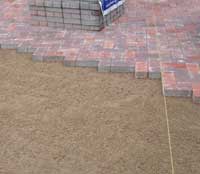How to Lay Paving
Ground Preparation
Remove all topsoil and dig down enough to reach hard ground for a good foundation.
Work out finished level of paving, work out falls in finished surface to remove surface water.
Then calculate the level of the underlying base by deducting the depth of paver and 50mm (2 inch) for the bed of sand.
For patios, a minimum of 100mm (4 inch) of stone is preferred, while under a driveway, use a minimum of 150mm (6 inch). (ask supplier for recommendations on stone type to use.)
Lay stone to required depth and compact with plate vibrator. Make up and compact where necessary to leave only 50mm (2 inch) of base sand depth.
Lay kerb or header paver as edge restraint.
You are now ready to begin paving area.
Sand Laying Course
 Set up levels to create falls to gullies or channels.
Set up levels to create falls to gullies or channels.
Choose a coarse concrete sand.
Spread an even layer deep enough to allow for compaction.
Sand Compaction
 Compact sand using a plate vibrator.
Compact sand using a plate vibrator.
Make sure to overlap all passes with vibrating plate.
Set up Screeds
 Set up screed boards in sand.
Set up screed boards in sand.
Top of board set to 5mm (one eighth of an inch) above finished level for bottom of paver.
Set boards to create falls to drainage gullies or channels etc.
Screeding
 Screed sand on top of screed boards with a straight piece of timber or aluminium.
Screed sand on top of screed boards with a straight piece of timber or aluminium.
Always screed off compacted sand, add more sand and compact if sand not high enough.
Fill remaining area
 When sand screeded remove the screed boards fill and compact the void left.
When sand screeded remove the screed boards fill and compact the void left.
Screed off remaining areas
 Carefully screed off these areas to level of surrounding sand.
Carefully screed off these areas to level of surrounding sand.
Laying Paving
 Choose pattern to lay paving to.
Choose pattern to lay paving to.
Set up a builders line as a guide to begin laying paving blocks.
Lay all blocks
 Continue laying until all full blocks have been laid.
Continue laying until all full blocks have been laid.
Lay header / string course
 Lay header or string courses along edges to create feature.
Lay header or string courses along edges to create feature.
This also leaves cutting much easier.
Cut Blocks
 Choose method of cutting blocks along edges.
Choose method of cutting blocks along edges.
Use either power saw or guillotine.
Carry out all cutting before moving to next process.
Compact Paving
 After checking and adjusting straightness of lines begin compacting paving with plate vibrator.
After checking and adjusting straightness of lines begin compacting paving with plate vibrator.
Compact entire area.
Do not compact closer than 1 metre from any unrestrained edge.
Fill joints
 Spread jointing sand and brush into joints.
Spread jointing sand and brush into joints.
Fill joints level to top of pavers.
Compact Sand

Compact sand into joints using plate vibrator.
Top up Joints

Top up joints with jointing sand.
Remove excess sand from surface leaving only a small amount on the surface.

